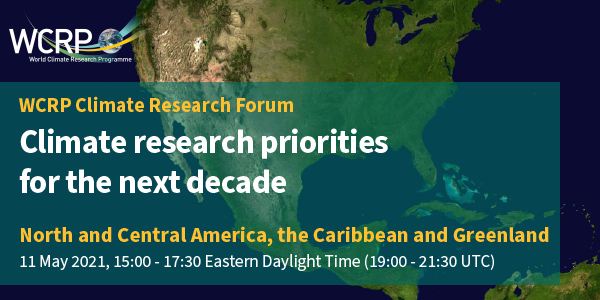11 May 2021, 15:00 – 17:30 Eastern Daylight Time (19:00 – 21:30 UTC) – Online

The World Climate Research Programme (WCRP) local organizing committee for the North and Central America, Caribbean and Greenland region, warmly invite you to the upcoming WCRP Climate Research Forum on “Climate research priorities for the next decade.”
This Forum will begin with an overview of WCRP from the Chair and Vice Chair of the WCRP Joint Scientific Committee (the scientific steering body of WCRP), Detlef Stammer and Helen Cleugh, followed by three invited talks on:
- Perspectives on the role, benefits and science imperatives of the WCRP
- Climate information needs from a user/policy maker perspective. Roberto Sánchez-Rodríguez, El Colegio de la Frontera Norte, Mexico.
- Earth system observations for assessing climate-related risks. Susann Tegtmeier, University of Saskatchewan, Canada.
- Advances and challenges in global and regional climate modeling. Andreas Prein, National Center for Atmospheric Research, United States.
This will be followed by a moderated discussion session that will include short presentations on:
- Collaboration activities in the region
- The Precipitation Prediction Grand Challenge, Louis W. Uccellini, NOAA, National Weather Service, United States.
- Understanding and Predicting Water Futures in an Era of Global Change. John Pomeroy, University of Saskatchewan, Canada.
- IAI’s strategic priorities in global change research, with a focus on climate and water. Anna Stewart, Executive Director, Inter American Institute for Global Change Research (IAI).
- The changing cryosphere in a warming climate, Dorthe Dahl-Jensen, Niels Bohr Institute, University of Copenhagen, Denmark, and the Centre for Earth Observation Science, University of Manitoba, Canada.
This is the third in a series of online Climate Research Forums, aimed at exchanging ideas, discussing new activities and opportunities being developed by WCRP, and exploring ways that our climate science community of scientists, partner programs, funders, and end-users can engage towards building “a world that uses sound, relevant, and timely climate science to ensure a more resilient present and sustainable future for humankind.” The Forum is without charge and is open to all, but we do ask that you register your interest.
Further information and details of how to register can be found at:

